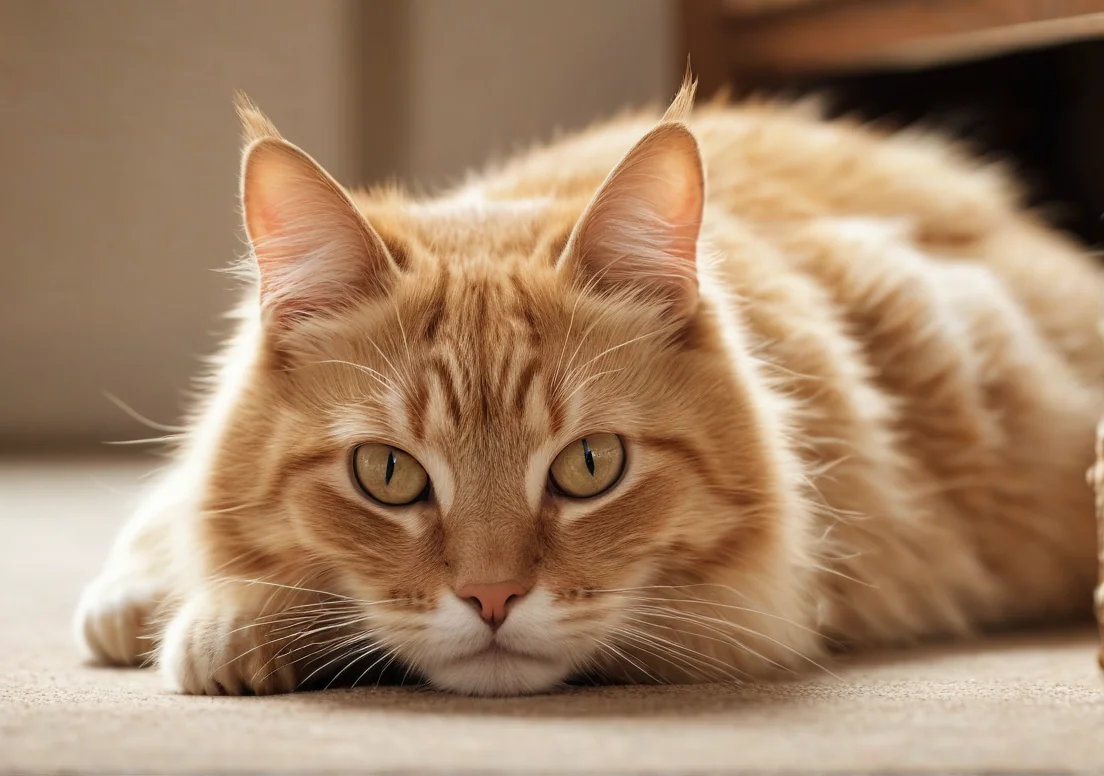Cats are known for their quirky behaviors, and one of the most intriguing is the low crawl. Whether it’s creeping stealthily across the floor or slinking along furniture, this movement captures our attention and curiosity. But why do they engage in such an entertaining display?
Cats low crawl primarily as a hunting instinct. This behavior mimics their natural predatory skills, allowing them to stalk their prey silently and efficiently. The answer, however, is just the start—there’s an interesting layer of feline behavior beneath this that you won’t want to miss.

What triggers the low crawl in cats
Cats have a unique way of communicating their instincts through body language, and the low crawl is one such behavior that can be an intriguing sight. This movement often stems from a few main triggers.
Firstly, hunting instincts play a significant role. When a cat is in a playful mood or experiences a sudden burst of energy, they might adopt a low crawling position to mimic crouching while stalking prey. This instinctive behavior remnant of their wild ancestors can manifest at any time, whether they’re playing with a toy or simply feeling feisty.
Additionally, fear or anxiety can prompt a low crawl. If a cat feels threatened—from sudden loud noises or unfamiliar situations—they may drop to the ground to make themselves less visible, adopting a stealthy posture reminiscent of a crouching hunter. This behavior is particularly common in multi-pet homes or during visits to the vet.
Lastly, the social dynamic with humans or other pets can influence this behavior. Cats often low crawl towards a favorite person, signaling submission or an invitation to play. If a cat is seeking comfort or reassurance, a low crawl can serve as a gentle approach, signaling that they come in peace.
Is low crawling linked to their environment
The environment greatly influences a cat’s low crawling habits. Various factors in their surroundings can make this behavior more likely, actively shaping how your feline friend interacts with their world.
-
Presence of hiding spots : If there are plenty of places for a cat to hide, such as furniture or boxes, they may feel more secure in their environment, leading to more low crawling as a comfortable, exploratory behavior.
-
Movement of objects : A fluttering curtain or a passing shadow can spark the hunting instinct, prompting even the most laid-back cat to adopt a low crawl as they prepare for the ‘chase’.
-
Other animals : Cats often lower themselves to develop their strategy when they see other pets in the vicinity, adjusting their behavior based on who they’re engaging with.
-
Human interaction : The energy in the home affects a cat’s response. If their human is energetic and playful, cats may mimic this energy with a low crawl, anticipating playtime or interaction.
For a deeper understanding of how environment and behavior intertwine in the feline world, consider exploring more insights at the ASPCA’s website ASPCA.org.
Keep an eye on those subtle environment cues and you might just decode your cat’s next low crawl!
Do all cats exhibit low crawling
Not all cats engage in low crawling, but it’s a behavior seen across many breeds. This position mimics stalking, a natural instinct tied to their ancestral hunting roots. Domestic cats, regardless of breed, display this behavior, though some may do it more often than others. For example, breeds known for their playful or high-energy nature, like the Bengal or Oriental Shorthair, might be more prone to low crawling as a way to express their excitement or playfulness.
Understanding the factors that lead to low crawling can help you figure out if it’s common for your furry friend. Individual personalities, their social environment, and their exposure to stimuli all play significant roles. Cats that have the freedom to explore or have stimulating interactions with companions are likely to exhibit this behavior more frequently.
In social situations, low crawling can serve several functions. It’s often a sign of playfulness and can provoke interaction. When cats engage in this behavior, they might be inviting others—cats or even humans—to join in a play session. It signals enthusiasm while also keeping them low and close to the ground, making them feel less vulnerable among others.
Interestingly, low crawling isn’t limited to play. It can also indicate submissiveness or curiosity when a cat is unsure about another animal’s intentions. For example, a cat might low crawl toward a new or dominant cat, showing that it poses no threat.
Here’s a quick list to highlight the social aspects of low crawling:
- Play Invitation: Cats low crawl to invite or entice others to engage in a playful chase.
- Non-threatening Behavior: It can signal that a cat is friendly and non-aggressive when approaching others.
- Exploration: They may low crawl while investigating their environment, showing their curiosity about new surroundings.
- Stress Response: Sometimes, it reflects caution or anxiety in unfamiliar situations.
For further reading on cat behavior, you can check out resources like the ASPCA. Understanding these nuances can make it easier to interpret your cat’s body language when they start to low crawl.
What role does play have in low crawling
Playtime isn’t just about having fun; it’s a crucial part of a cat’s natural behavior, often bringing out their instinct to low crawl. When cats engage in interactive play, especially with toys that mimic prey, their hunting instincts kick in. You might notice them adopting a stealthy posture, belly close to the ground, as they sneak up on their “prey.” This behavior mimics how wild cats approach their targets, using low crawling to stay below the radar.
Interactive play that involves pouncing, stalking, or chasing encourages this instinctual response. Feather wands, laser pointers, and toy mice are fantastic tools to stimulate this natural behavior. Each time your cat crouches and crawls low in the thrill of the chase, they’re honing their hunting skills. Plus, it’s a great way to bond with your feline friend while keeping them active, healthy, and mentally engaged.
Are there health implications behind low crawling
Low crawling can sometimes be more than just playtime antics. While it often signifies your cat is in a playful or hunting frame of mind, it might also indicate underlying health issues. For instance, if a cat is suddenly low crawling more than usual, it could be due to discomfort or pain. Cats frequently adopt this posture when they’re trying to minimize stress on their bodies or if they’re experiencing back or joint pain.
Additionally, anxiety can lead to low crawling. A stressed cat might feel the need to stay low to avoid perceived threats. Changes in environment—such as a new pet or loud noises—can trigger this response.
Here are a few health-related signs to watch for: – Changes in appetite or grooming: Could indicate discomfort or stress. – Limping or reluctance to jump: May point to injuries or arthritis. – Excessive hiding or avoidance: Suggest anxiety issues.
It’s worth consulting a veterinarian if you notice any of these alongside increased low crawling behaviors. Taking proactive steps can make all the difference in keeping your feline friend comfortable and happy. For more information on cat behavior and health, check out this resource from the American Association of Feline Practitioners.
Understanding these behaviors can help you provide the right support for your cat, whether through more engaging play or addressing any health concerns.
Interesting facts about cat behavior
Cats are fascinating little creatures, and their low crawling, sometimes called “stalking,” is just another quirky behavior that showcases their unique personalities. Here are a few noteworthy insights:
-
Hunting Instincts: Cats have an innate desire to hunt. When they low crawl, they’re channeling their predatory instincts, mimicking the stealthy approach they’d use when stalking prey.
-
Communication Cues: Low crawling can also serve as a form of communication. Your cat might be trying to signal playfulness, excitement, or even submission, depending on the context.
-
Confidence Levels: Not every cat crawls like this. A cat’s tendency to low crawl can be indicative of their confidence levels. Shy or cautious felines are more likely to sneak around, while bolder ones may strut their stuff confidently.
-
Temperature Regulation: Cats tend to prefer warm spots, and low crawling can be a way to find sunlit areas on the ground while avoiding cooler air higher up, unknowingly using a survival tactic.
These behaviors collectively highlight the intricate balance of instincts and environmental response that define cat behavior.
How can you encourage or discourage this behavior
Shaping your cat’s crawling habits can be both interesting and beneficial. If you’re looking to encourage low crawling for playtime fun or to burn off some energy, try these tips:
-
Create Puzzles: Set up engaging obstacles with furniture or toys, prompting your cat to low crawl through them. This not only mimics hunting scenarios but keeps them mentally stimulated.
-
Interactive Toys: Use wand toys or laser pointers, as they encourage your feline friend to stalk and pounce, igniting that natural instinct in a controlled manner.
If you’re keen to discourage low crawling, especially in social situations, consider the following:
-
Positive Reinforcement: Reward your cat with treats or affection when they exhibit more confident behaviors. This can help shift their inclination toward a more social demeanor.
-
Safe Spaces: Ensure your home has open spaces with minimal hiding spots. Reducing clutter can make them feel more secure, thereby lowering their need to sneak around.
Lastly, always observe your cat’s reactions. Every cat is unique; adapting your approach based on their comfort level is key. For more insights into feline behaviors, you can explore resources like the ASPCA’s pet care tips.
What does your cat’s low crawl say about their personality
A low crawl can reveal a lot about your cat’s personality, often reflecting their instinctual behaviors and comfort levels in their environment. Cats exhibit this behavior for several reasons, primarily related to their natural prey instincts. When a cat low crawls, they might be mimicking the stealthy approach of a predator or simply engaging in play.
If your cat frequently adopts this posture, they could be expressing a playful and curious nature, keen to explore their surroundings without drawing attention. It’s often seen in younger cats who are still honing their hunting skills. Conversely, if a more established cat is low crawling, it could hint at their cautiousness or shyness. These cats may prefer to keep their distance, observing from a safe zone to gauge their surroundings before fully engaging.
Additionally, cats exhibiting a low crawl might be testing their boundaries or expressing territorial instincts. They may sense something intriguing within their environment—be it an interesting scent or an unseen movement—leading them to adopt a more calculated approach. Some breeds, like Siamese or Bengals, are more likely to display this behavior due to their highly active and inquisitive nature.
Here’s a quick rundown of various personality traits linked to low crawling:
- Playful: Often seen in younger cats, getting ready for a pounce.
- Cautious: Shyer cats may prefer to approach situations more stealthily.
- Curious: A low crawl can indicate fascination with new sights or sounds.
- Territorial: Cats may low crawl to assert themselves in a new area.
Next time your cat low crawls, consider the context. Are they playing, on a hunt, or simply exploring? It’s all part of understanding what makes your furry friend tick. Want to learn more about cat behavior? Check out the ASPCA’s guide on feline behavior for deeper insights into these fascinating creatures: ASPCA Feline Behavior.
Alex, a passionate animal lover, has experience in training and understanding animal behavior. As a proud pet parent to two dogs and three cats, he founded AnimalReport.net to share insights from animal experts and expand his knowledge of the animal kingdom.




